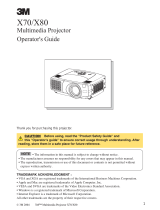
1. Serial communications Basics
1.1 Communication Protocol
Communication protocol summary
Like every communication method the serial communication uses a particular protocol (ANSI) which must be respected in order to
allow communication to take place, following table gives a summary of the predefined communication terms.
Start byte \xfe
Projector address
Command byte(s)
Data bytes
1
Checksum byte
Stop byte \xff
ANSI
American National standards Institute
Start byte
The “Start byte” informs the projector (in case of transmission) or the computer (in case of reception) that a new data transfer will
take place
Projector address
The “projector address” defines the address of the computer the projector wants to talk to (in case of transmission) or the address
of the projector that answers (in case of
reception).
The maximum number of projectors th
at can be ad dressed by one co mp uter is 256.
Comman d byte (s)
There is at least one command byte to define the action to be performed. Commands that are not often used or complex commands
can take more than one byte. All command bytes that are sent by the computer to get information out of the projector are repeated
in the answer-data-transf
er of the projector.
Data bytes (optional)
Whether the command bytes are followed by one or more data bytes depends on the contents of the command bytes.
Data which contains more than one byte is called a word and can also be signed or unsigned.see "Data words", page 4
Some commands do not requ ire a data field(s)
Checksum byte
The “Checksum byte” is used to detect errors during transmission or reception
Checksum byte = (projectoraddress + command bytes + Data bytes) Modulo \x100
Stop byte
The “Stop byte” informs
the projector (in case of transmission) or the computer (in case of reception) that the data transfer is complete
and that the interpretation of the command and data bytes can start.
Acknowledge (ACK)
If the communication link and if the sent commands can be interpreted by the projector an “ACK” command is sent back. In case the
commands cannot be interpreted a “NACK” command is sent back.
1. optional
2 R5976841 ID (PRO) R600/R600+ 19/09/2006





















